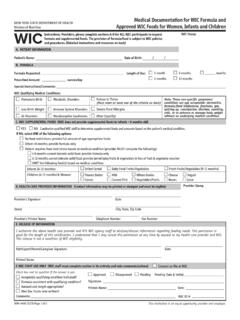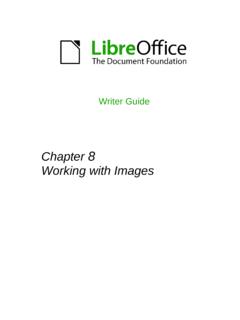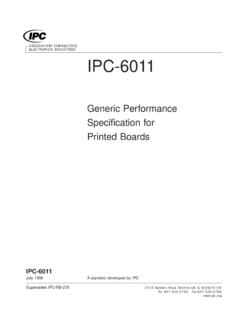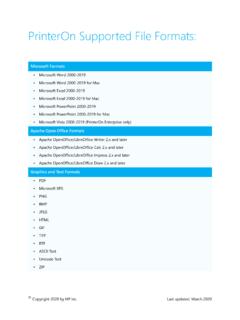Transcription of Software Documentation - Literate Programming
1 Software Documentation Ian Sommerville Lancaster University, UK. Software Documentation , Page 1, printed 7/11/01. Introduction All large Software development projects, irrespective of application, generate a large amount of associated Documentation . For moderately sized systems, the Documentation will probably fill several filing cabinets; for large systems, it may fill several rooms. A high proportion of Software process costs is incurred in producing this Documentation . Furthermore, Documentation errors and omissions can lead to errors by end-users and consequent system failures with their associated costs and disruption.
2 Therefore, managers and Software engineers should pay as much attention to Documentation and its associated costs as to the development of the Software itself. The documents associated with a Software project and the system being developed have a number of associated requirements: 1. They should act as a communication medium between members of the development team. 2. They should be a system information repository to be used by maintenance engineers. 3. They should provide information for management to help them plan, budget and schedule the Software development process. 4. Some of the documents should tell users how to use and administer the system.
3 Satisfying these requirements requires different types of document from informal working documents through to professionally produced user manuals. Software engineers are usually responsible for producing most of this Documentation although professional technical writers may assist with the final polishing of externally released information. My goals here are to describe the Documentation which may be produced during the Software process, to give some hints on ways of writing effective documents and to describe processes involved in producing these documents. I. start by discussing different types of Documentation that may be produced in a Software project.
4 I then cover the important topic of document quality and discuss document structure, Documentation standards and effective writing style. Finally, I cover processes of preparing, producing and managing documents. My focus in this paper is on Documentation that is intended to be printed and so is delivered on paper or in a format such as PDF which may be viewed on a screen or locally printed . Many systems now also have associated hypertext help systems. Producing these systems requires a different set of skills from producing paper Documentation and I only discuss these briefly here. Software Documentation , Page 2, printed 7/11/01.
5 Process and Product Documentation For large Software projects, it is usually the case that Documentation starts being generated well before the development process begins. A proposal to develop the system may be produced in response to a request for tenders by an external client or in response to other business strategy documents. For some types of system, a comprehensive requirements document may be produced which defines the features required and expected behavior of the system. During the development process itself, all sorts of different documents may be produced project plans, design specifications, test plans etc.
6 It is not possible to define a specific document set that is required this depends on the contract with the client for the system, the type of system being developed and its expected lifetime, the culture and size of the company developing the system and the development schedule that it expected. However, we can generally say that the Documentation produced falls into two classes: 1. Process Documentation These documents record the process of development and maintenance. Plans, schedules, process quality documents and organizational and project standards are process Documentation . 2. Product Documentation This Documentation describes the product that is being developed.
7 System Documentation describes the product from the point of view of the engineers developing and maintaining the system; user Documentation provides a product description that is oriented towards system users. Process Documentation is produced so that the development of the system can be managed. Product Documentation is used after the system is operational but is also essential for management of the system development. The creation of a document, such as a system specification, may represent an important milestone in the Software development process. Process Documentation Effective management requires the process being managed to be visible.
8 Because Software is intangible and the Software process involves apparently similar cognitive tasks rather than obviously different physical tasks, the only way this visibility can be achieved is through the use of process Documentation . Process Documentation falls into a number of categories: 1. Plans, estimates and schedules These are documents produced by managers which are used to predict and to control the Software process. 2. Reports These are documents which report how resources were used during the process of development. 3. Standards These are documents which set out how the process is to be implemented.
9 These may be developed from organizational, national or international standards. Software Documentation , Page 3, printed 7/11/01. 4. Working papers These are often the principal technical communication documents in a project. They record the ideas and thoughts of the engineers working on the project, are interim versions of product Documentation , describe implementation strategies and set out problems which have been identified. They often, implicitly, record the rationale for design decisions. 5. Memos and electronic mail messages These record the details of everyday communications between managers and development engineers.
10 The major characteristic of process Documentation is that most of it becomes outdated. Plans may be drawn up on a weekly, fortnightly or monthly basis. Progress will normally be reported weekly. Memos record thoughts, ideas and intentions which change. Although of interest to Software historians, much of this process information is of little real use after it has gone out of date and there is not normally a need to preserve it after the system has been delivered. However, there are some process documents that can be useful as the Software evolves in response to new requirements. For example, test schedules are of value during Software evolution as they act as a basis for re-planning the validation of system changes.






